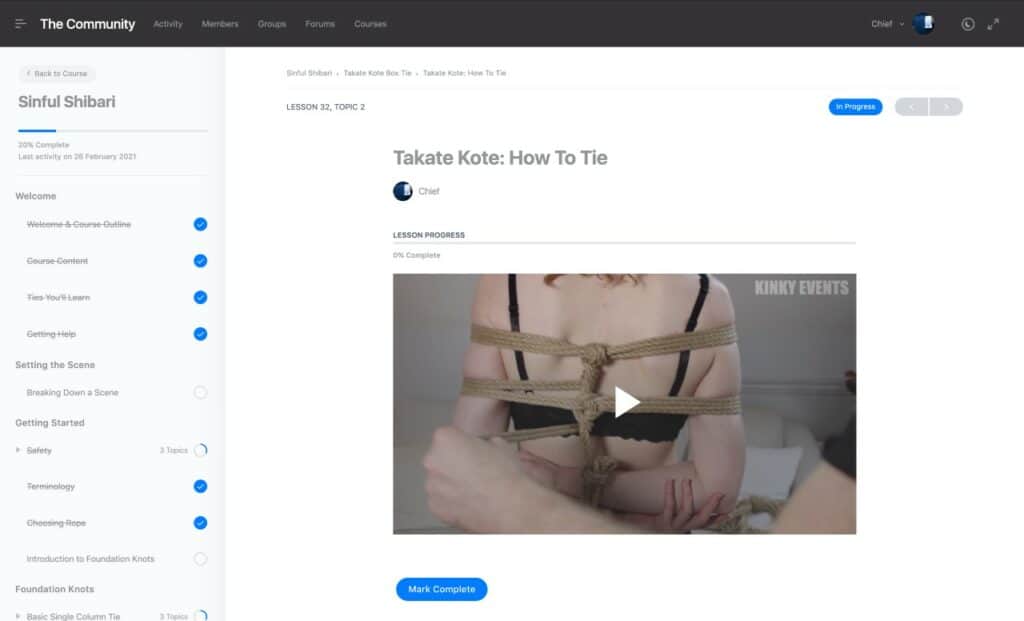In this rope bondage tutorial for beginners you’ll learn the exactly what you need to know about Shibari bondage (Japanese bondage), including the best rope for bondage, the best bondage rope ties and BDSM knots.
It’s the best guide aimed at those Dominants and submissives who want to experience the thrill of being restrained during sexual play, or as part of their dynamic.
In this guide I’m going to cover everything you need to know as a beginner rope bunny or rigger to get started, including
- What it involves
- How it can be incorporated into a dom sub dynamic
- Why submissives enjoy being restrained
- How to practise rope safely
- Which rope to buy and why
- The foundation BDSM knots you need to learn
- Knowledge of the main ties to get you started
I’m writing this guide because when I started I couldn’t find anything like it. I had to wade through lots of youtube videos and multiple sites in order to get a sense of not only how to restrain someone with rope, but how to incorporate it into sexual play. Most sites don’t cover these two aspects together, so I wanted to.
If you enjoy the content do take a look at my rope bondage for D/s dynamics video course which goes into greater detail about many of these topics.
- What is rope bondage?
- Why would you want engage in rope bondage?
- Benefits of using rope for bondage vs other restraints
- Uses of rope restraints in a Dom sub relationship
- Best rope for bondage
- Types of bondage rope available
- The benefits of each rope material type
- Treating bondage rope
- Bondage rope length and diameter
- So which bondage rope should you buy?
- Rope bondage safety
- Getting started: Rope bondage for beginners
- Rope bondage positions
- Rounding up this beginner’s guide to rope bondage
What is rope bondage?
Rope bondage is the art of tying someone up with rope in order to restrain them. Bondage is one of the core pillars of BDSM and lots of people engaged in D/s dynamics enjoy it.
This form of bondage is often referred to as Shibari, which broadly means ‘tying’ or ‘binding’ in Japenese.
Although there are many ways or restraining someone, rope tends to be the most popular because it is cheaper than buying purpose built restraints such as under mattress restraints, and can be very pretty when done correctly.
There’s also an unlimited number of ways you can restrain someone with rope, making it incredibly practical.

What is Shibari?
Shibari is a style of Japanese rope bondage. People often use it interchangeably with the term ‘rope bondage’, but if we are being pendantic, they are a bit different. Shibari was developed to restrain prisoners and criminals in Japan, and is now used to restrain someone as an art form, or for sexual play.
Shibari is more intricate and detailed that ‘just tying someone up with rope’. The knots are prettier and the patterns more decorative. So tying someones wrists together in a really basic way probably isn’t Shibari. But doing so with flair and style, using artful knots probably is.
Why would you want engage in rope bondage?
People decide to use rope restraints for a variety of reasons.
Personally I use them as part of my dom sub dynamic to tease, relax and provide sexual satisfaction to my sub. And whilst I don’t get turned on by the act of tying itself, I do enjoy the sight of my sub restrained once I’m done, ready and waiting for my commands or to be used (yes, we’re into free use if you hadn’t guessed).
Other people enjoy being restrained by rope for the feel of it against their skin. If a sadist is paired with a masochist and they use rope restraints, the sadist might enjoy tying the rope extra tight, causing pain and discomfort in the masochist, which she gets off on.
When you are tied up and completely exposed naked on a bed, your partner nearby, you can’t help but wonder what’s going to happen next. That rush of anticipation is intoxicating. Will your partner be naughty or nice? Will they teach you a lesson because they are feeling sadistic or give you the best orgasm of your life because they are feeling generous, or will they massage you until you are fully relaxed because they are feeling caring?
Others simply like using rope restraints as a hobby – using the human body as a canvas on which to create their artwork.
If you’re on this website you are probably interested in using rope restraints in a Dom sub dynamic, where the dominant partner ties up his submissive for sexual play, punishment or training purposes (refer to the big 5 scene themes).
Benefits of using rope for bondage vs other restraints
Rope is a good method of restraint to get started because the investment is small, the rope can be stored away easily, and is relatively easy to learn but very versatile.
- It’s cheap. For under $10 (£10) you can grab yourself a length of 7m or 10m soft cotton rope and a pair of EMT shears (for safety). Leather cuffs, metal handcuffs, silk ties and under bed restraints are expensive and only have one purpose. Learn to replicate the functionality of these pieces of bondage equipment with a bit of rope and you’ll save yourself money, plus have lots of creative fun in the process.
- It’s easy to find. Cotton rope can easily be found online or in many hardware stores, as unlike a dildo, it’s something you can use innocently too! If you want to buy more professional rope then there a plenty of sellers online such as Esinem Rope or Anatomie Studio here in the UK.
- Easy to store. As mentioned, rope won’t raise as many eyebrows as leaving a butt plug lying around.
- It’s versatile. Once you know the basics you can use it in multiple ways to restrain your partner, replicating many of the things you would do with more traditional sex toys or BDSM equipment. For example, rather than buying an expensive pair of handcuffs, you can make a pair out of rope. Or that $100 spreader bar you were eyeing up? You can achieve a similar position with the rope.
Uses of rope restraints in a Dom sub relationship
During sexual play
The most obvious choice is sexual play.
You tie someone up, and they get the feeling of being helpless whilst you feel in control. It’s primal. There’s elements of consensual non-consent – the victim being forced against her will to do things she wouldn’t have done under normal circumstances.
For some this can be sexually liberating (and one of the reasons I think people are drawn to D/s in the first place).
By effectively having someone else in control, the guilt and shame they may feel about sex, or doing certain things they’d love to do is removed. It’s one of the reasons why dom sub relationships can lead to the best sex.
Here are some ways to use rope in sexual play.
Forced orgasms
The submissive is restrained and then made to orgasms by the Dominant. Personally, I like to use a magic wand vibrator (see my toy chest) for this as the vibrations are powerful, it doesn’t run out of batteries being mains powered and has an easy to use wheel which varies the intensity.
Essentially you give your submissive an orgasm in whichever way you want, but then proceed to give them another orgasm, and so on. Some of you subs out there might be thinking this is heaven! Most women I’ve met have an orgasms limit though at which point coming become uncomfortable, usually because the clitoris becomes too sensitive.
In a forced orgasm this sensitivity is ignored by your Dominant, and they proceed to continue to stimulate you, even though it’s uncomfortable.Some submissives enjoy this, and are able to work through the discomfort and orgasm again.
Forced orgasms might also be ‘forced’ because the submissive is mentally exhausted from previous orgasms, rather than because they are too sensitive. Rope restraints can be used to hold your submissive in place (for example tying her ankles and wrists to the bed posts) or it can be used to hold toys in place (for example holding a magic wand against her).

Forced oral
My sub loves giving blowjobs, but she also enjoys a good, rough, face fucking. By tying her hands behind her back and having her kneel in front of me, I can grab her hair and guide her onto me as gently or firmly as I want (Yes, this is all consensual. It has been discussed and talked about at length and we both enjoy it).
Consensual non-consent
CNC scenes are ones in which kidnap and rape fantasies are acted out (with both partners acting in a sane, safe and consensual way). To make these scenes realistic, rope can be used to mimic being held captive and not able to escape.
‘Just starting out’ feeling of being overpowered
There’s a reason Ann Summers sells pink fluffy handcuffs. Lots of people enjoy the feeling of being restrained during sex, even if it is mostly an act and they could escape if they wanted to. If you feel you might enjoy being tied up by your partner in the bedroom, then learning rope is the way to go. All you need to know is how to tie two wrists together to get started, something which can be learned in 5 minutes.

General teasing
If you aren’t into the rough stuff such as CNC, forced orgasms or forced oral, you might enjoy being lightly teased as part of foreplay, allowing the anticipation to build before you get to intercourse with your partner.
For example, tie your partner up then lightly run your fingers over her naked body, ignoring sensitive areas such as nipples and between her legs. Run your fingers slowly up her inner thigh then stop right before you would otherwise have brushed her labia, then run them back down the other thigh.
If you don’t believe this is a turn on, think back to a time when a woman did it to you. You were dying for her to take you in her mouth, but perhaps she just kept kissing your inner thighs. You knew she was going to take you, just not when.
Hot isn’t it.
Now these aren’t the only ways you could incorporate bondage into sexual play. They are many more. But that’s the beauty of rope. Knowing the techniques is a versatile skill which any Dominant should learn because it really can be used in so many ways.
For punishment
Shibari was conceived by the Japanese as a form of torture, so it’s entirely fitting for it to be used within BDSM relationships as a form of punishment. Examples of punishment (and funishment) include:
Punishment corner
Restricting someone’s movements and taking away their freedom is punishment. Tie their wrists and have them stand in a corner like a naughty child. Although they could escape, the symbolism of being made to take the punishment of a small child is enough to cause embarrassment, humiliation, and hopefully better behaviour in the long run!
Breast bondage
During breast bondage ropes are tied tightly around the breasts causing discomfort and pain. If you’ve ever watched bondage porn, featuring a dimly lit dungeon, you often see these types of ties in use. Perfect if your submissive is into masochism and you’re a sadist.
Chastity bondage
The taking away of the ability to have sex is a huge turn-on for some. Rope can be tied around the waist in such as way that it prevents erections, or blocks access to the vagina. Because it’s rope, it can obviously be circumvented and isn’t as secure as a metal cock cage or chastity device, but the ILLUSION of chastity and someone else being in charge of your sex life is still arousing.
Predicament play and anal hooks
Predicament play puts someone into a position where they have to make a tough choice between two different types of discomfort.
For example, if an arm binder tie was used (which ties someone’s arms straight behind their back) and then another rope was attached to the arm binder pulling it upwards towards the ceiling, you could put someone into a predicament position by tightening it just enough so they are forced to stand on tiptoes. They then have the choice between sore calves or having their feet flat on the floor which puts more pressure on their arms.
Another type of predicament bondage involves the use of anal hooks. An anal hook is a metal hook with a large ball on one end which is inserted into the anus. On the other end is a loop through which a rope is run, and then tied to the submissives hair.
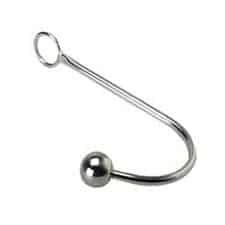
If she relaxes her neck the anal hook is pulled deeper inside her. If she keeps her head up, the anal hook is somewhat comfortable, but the strain is then on her neck. I recommend not engaging in predicament play unless you really know what you are doing. Bondage is already a bit risky, and adding predicament elements make it even more so.
Generally uncomfortable ties
There are ways to tie someone which makes it very uncomfortable for them. Not necessarily due to the pressure of the ropes around the limbs, but rather that position which the configuration of the ropes forces someone into.
For example, the Strappado has a person’s arms bound straight behind their band, then lifted up by the wrists, forcing the person to bend at the waist to avoid shoulder dislocation. This is an extreme bondage position and should only be attempted by those who know what they are doing due to the obvious dangers.
The Shrimp Tie is another, slightly less risky tie which forces your rope bottom into an uncomfortable position.
For relaxation
Some enjoy being restrained because it helps them relax. My sub tends to become very sleepy when I tie her up, and often has a snooze after our sessions.
Why?
She describes being tied up like having a comfort blanket. When restrained she is unable to do anything except embrace the present. Anything else going on in her life is put on hold, because there’s nothing she can do about it in that moment. This leads to her mind becoming quiet, much like meditation, allowing her to enter a relaxed state, a form of subspace.

People who are very much into rope will often self-tie (tie themselves up), not because it is sexual, but because they want to experience that feeling of being worry free and able to relax.
There are a number of ties such as the Hishi Karada rope dress or chest harnesses which can be worn under clothes whilst you are out in public. This gives the nice relaxing sensation, plus you will know you’re being kinky in public (which for some people, myself included, is a turn on).

So although bondage is talked about in a sexual context, don’t forget it can be used to help your submissive relax. Not all submissives will find it relaxing however, so you’ll have to ask your partner her thoughts. If she has anxiety problems or is always worrying about things or having intrusive thoughts, it might be helpful.
As an art form
A final reason people gravitate towards rope bondage is that it looks so damn good! Not only is it teasingly sexual, but it is very aesthetically pleasing to look at. I often see beautiful images of models suspended from the ceiling in dream-like poses with artistic lighting and wonder firstly how the hell they managed to tie that, but secondly just how amazing it looks as a stand-alone piece of art.
Japanese bondage doesn’t have to involve naked flesh or sex at all. You might just want to attend a rope jam to make friends and learn to tie simply as a creative outlet, a new hobby.

Best rope for bondage
The only piece of equipment you need to get started is…well, rope. But rope comes in manny different flavours. What is the best rope for bondage?
Types of bondage rope available
Visit any Shibari website or lookup bondage videos on YouTube and you’ll mainly see people using light, sand coloured rope about the thickness of your little finger.
Most likely they are using Jute rope or Hemp rope. These are natural ropes made from natural fibres. Whilst not specifically made for bondage or to be used as rope restraints, they get used nonetheless for their feel, strength and nice handling properties.
But that isn’t the only type of rope you can use for bondage.
You can also use cotton rope, nylon rope or polypropylene rope.
The benefits of each rope material type
Here are some things to keep in mind when looking for Shibari rope.
Cotton bondage rope
Cotton is a natural fibre rope, just like Jute and hemp. However, unlike those two, because cotton is widely available and used in clothes, cotton rope is readily available and manufactured regularly. This makes cotton rope plentiful and available from a lot of outlets at a very low price.
For example, on Amazon you can buy three bundles of 10m of cotton rope for $5 to $10 dollars!

Cotton rope is very supple, with a silky feel that feels lovely against the skin. However, due to the way it’s made it can suffer from stretching, and the ends can become frayed, or become elongated with use. So, although you’d never see a pro Shibari master using cotton rope, for a beginner it is perfect to get started due to its low cost and a variety of colours available.
Hemp and Jute bondage rope
What the pros use. These ropes tend to only be available in a single colour (natural brown) but they look great in photos.
Hemp and Jute ropes are stiffer than cotton rope but flexible enough to tie with. They are rougher against the skin than cotton rope, but soft enough not to be uncomfortable.

BDSM knots tied with cotton rope can become tightly compacted and very difficult to undo. Hemp and Jute ropes need much more tension to compact the knots tight enough to be unpicked. The downside of natural fibre ropes such as these is price. They are far pricier than man made ropes. You are looking at around £15 ($20) for a 10m length of untreated rope.
The other downside of natural rope is shedding. As you work with it little strands of fibre shed off, getting in the air and on your clothes. Some people can be allergic to natural fibre rope too.
Nylon bondage rope
Nylon rope is man-made and the type of rope you find on boats. It’s relatively inexpensive (not as cheap as cotton) and can be picked up from DIY and boating stores. Personally, I find it a little still and scratchy, so wouldn’t use it.

Polypropylene webbing (climbing rope)
Climbing rope is smooth and slippery, making it fast to work with. It undoes easily and very strong. It’s low friction means you are unlikely to suffer rope burn, but it also means knots may not hold very well, and it can slip on skin. It has a moderate price tag too, so unless you already have some lying around I still recommend you go for Hemp or Jute.

Treating bondage rope
If you do buy natural fibre rope like jute or hemp, you should be aware that they come in three varieties.
- Untreated bondage rope. The rope is provided as is with no treatment applied to it after weaving. Natural hemp and natural untreated jute have a stiff feel to them, and lots of mini strands of material hanging off them. The rope feels firm, and whilst it isn’t very scratchy, it’s not silky smooth either. It has a certain roughness to it. However, with use, the strands of fibre do shed and the rope becomes more supple and useable.
- Dry treated bondage rope. Dry treating rope is a process by which natural rope is taken and rubbed with oil or wax. This treatment process is sometimes done by taking a rag covered in oil and running it over the rope. The treatment of the rope this way gives it a smoother, silkier feel. It slides better over the skin and can aid when tying BDSM knots. It’s also less likely to shed all over your floor and clothing! Bear in mind that rope becomes naturally dry treated if you work with it a lot because the oil from your hands and the person being tied seeps into it.
- Wet treated bondage rope. During the wet treatment process, the bondage rope is soaked in water, then hung out to dry under tension. If you want to clean your ropes you can wash them in hot water (which is basically wet treating them). Fail to dry them under tension and you’ll end up with a rope which isn’t usable for Shibari, which is why most people opt for dry treating if they are doing it themselves at home.
When you buy rope from specialist suppliers they will often give you the choice of ordering it natural or treated. It’s a matter of personal preference what you should go for. Just bear in mind that treating the ropes will add cost, and you can do it yourself.
If you do buy untreated rope, bear in mind that it would be wise to treat it. Without treatment, the friction from continual use of the strands rubbing over one another will cause the rope to deteriorate and eventually break, requiring you to purchase more rope.
Therefore, you might be better off paying to buy treated rope from the outset, and learning how to dry treat your rope every once in a while to keep it feeling and looking great.
Bondage rope length and diameter
Another choice you have to make is what diameter and length of rope to buy. Bondage rope comes in different mm thicknesses. Personally, I use 6mm rope which feels great in the hands, but this is a personal preference. You might prefer thicker or thinner.
I own four jute ropes (and some cotton ropes too but I’m not counting those), two in 10m and two in 7.5m lengths. If I bought again I would buy some shorter lengths too, as the longer ropes leave a lot of excess if only doing simple ties.
That said, I highly recommend a 10m rope so that you have enough length to do lots of tying and wraps around the body.
If you run out of rope during a tie it’s very straightforward to extend the rope by attaching a second one to it. It looks a bit messy as you’ll have a knot potentially where it shouldn’t be ruining the aesthetic. As long as you position the knot so it isn’t uncomfortable for your rope bottom, it makes no practical difference aside from looks.
So which bondage rope should you buy?
If you are completely new to rope bondage and have no idea whether you will like it or not, I suggest buying cheap cotton rope in your favourite colour. For just a few bucks you’ll be able to buy 3 or 4 lengths, and they require no treatment. If you decide rope bondage isn’t for you, then you haven’t wasted much more than the price of a cup of coffee.
If you are pretty sure rope bondage is for you, or you have plenty of money, then buy hemp or jute from a proper Shibari store. I bought untreated as it is cheaper and chose to self treat them at home.
Rope bondage safety
Rope bondage is dangerous if done incorrectly, and therefore no guide to rope bondage for beginners would be complete without talking about safety.
You should always think safety first and work to minimise risk to your submissive when tying.
What makes rope bondage unsafe?
The primary risks of rope bondage are:
- Nerve damage. Nerve damage occurs when rope is tied too tightly around a nerve, compressing it. The longer the nerve is compressed the more damage which will occur. Symptoms of nerve damage are numbness or decreased sensation in an area supplied by the nerve; sharp, aching or burning pain; pins and needles sensations; muscle weakness; feeling like a hand or foot has ‘fallen asleep’. Nerve damage can be temporary and recover in a few minutes or permanent, never fully healing or taking months to heal.
- Loss of circulation. If a rope is tied too tightly it can cut off blood flow to parts of the body. The body is pretty resilient and can deal with loss of circulation for about an hour which any lasting damage. However, it’s best to avoid it in the first place.
- Head injuries due to falling. With hands tied a person has no way to break their fall should they trip. Likewise, if their ankles are tied when standing, they are more likely to trip and injure themselves.
- Joint injuries. If a tie is tied incorrectly and lots of tension put on the rope or it is tugged suddenly, it may result in joints being displaced. An example would be the Strappado in which the arms are bound behind the back and then the person is suspended by them. Left in this position the shoulders will dislocate. Shoulders are probably the most at risk joints when practising Shibari, but all joints should be monitored.
- Strangulation. An obvious one. Tying around the neck is a big no-no. Do not do it under any circumstance. However, strangulation can occur if ropes placed around the shoulders slip upwards accidentally.
- Inability to communicate. If your submissive is bound and gagged, she won’t be able to say the safeword or inform you if she is uncomfortable and wants activity to stop.
- Subspace. Submissives may go into subspace making it difficult to communicate. Learn to recognise the signs of subspace and remember to monitor your partner at all times.
How to minimise rope bondage risk
Now you know the risks, here are some principles to stick to to keep things safe.
- Have scissors handy. Always have a pair of EMT shears nearby to cut your rope bottom free should something go wrong.
- Have a safe word or action. Give your submissive a safe word to say in case she wants you to immediately stop what you are doing. You should also have a non-verbal safe word (for example three taps on the bed or your body). Another method is to regularly place your hand into your submissives and give a squeeze. If she squeezes back it means she is ok and wants to continue. If she doesn’t squeeze back it means there’s a problem. Finally, I recommend having her hold a small, heavy object such as a golf ball. If she gets into trouble and is unable to say the safeword (due to being gagged) she can drop or throw the object.
- Avoid nerves. Do not tie ropes in areas where nerves are close to the skin or at risk. These include the wrist, elbow, above and below the knee and groove of the tricep and shoulder.
- Check for skin colour changes. Monitor your partner for skin colour changes above and below where you have laid ropes. If one side is very different to the other then there’s a change you have cut off circulation.
- Go looser at first. When you start out, err on the side of caution. Tie the ropes looser and ensure you can fit one or two fingers between the skin and the rope as a precaution.
- Don’t attempt suspension. Do not attempt to suspend any limb or the entire person without proper training. Stick to floor ties where the person is standing, kneeling or lying down. Suspension puts extra tension on the limbs, and therefore increases the change of nerve damage, but there’s also the danger of falling if the rope breaks or isn’t tied correctly.
- Remain with your submissive at all times. Do not leave your rope bottom restrained and leave the room. If she gets into trouble you need to be there to help out.
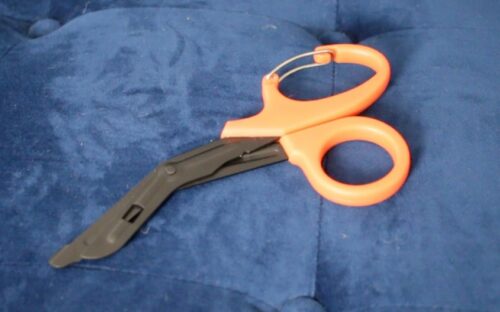
Getting started: Rope bondage for beginners
Now you’ve learned why bondage is fun, and know how to perform it safely, you’re probably wondering what knots you need to know. Does it take years to learn or is it something you can master in a few minutes?
The good news is, beginner bondage can be performed in just a few minutes. Grab a bit or rope, loop it around your partners wrist, tie a knot and you’re done.
But I’m oversimplifying things. Yes, the above is technically rope bondage, but you probably already know how to do that. If you’re reading this arttlce you probably want to know a little more, and how to tie knots like a professional rigger would.
Fundamental Shibari/japanese knots
Once again, the good news is there are a handful of knots you need to know to get started, but all of them can be learned in a few hours of studying. In fact, I cover all of them in my rope bondage for beginner’s course. These knots are the cornerstone of pretty much all ties, and should be the first thing you learn.
Here’s what you should learn:
Granny and square (reef) knots
The granny knot is the classic knot a child would use when tying two pieces of rope together. The square knot is similar but has a slightly different ending to the square knot. Both are quick to tie but can collapse under tension. This means the knot shifts around and turns into a slip knot, tightening against your partner when you don’t want it to. However, some people like the square knot because they want to be able to undo it whilst it is under tension (which is why the square knot was used to reef sails on ships).

Somerville bowline
The bowline is more complex to tie but does not collapse. It’s a better knot to tie if you know the rope is going to be under lots of tension. There are other variations such as the Burlington bowline, but I stick with the Somerville.
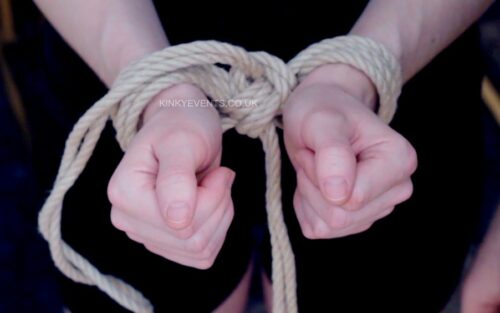
Lark’s head
The Lark’s Head is a reverse tension knot where one end of the rope passes through the loop of the other end. The lark’s head is a good method for attaching rope around the torso at the start of a tie.
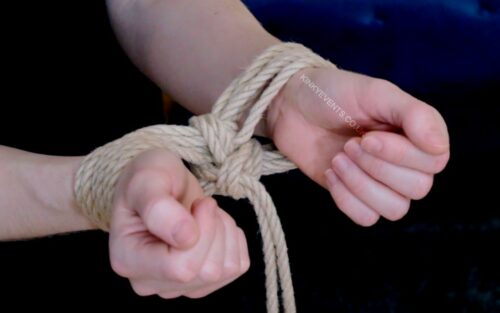
Half-hitch
Half hitches are simple friction knots often used in the middle or end of a tie to lock off a rope and prevent it from coming undone. Two half hitches tied together to provide enough friction that they don’t easily slip.
(By the way, I teach all of these knots in my rope bondage for sexual play course)
Learning the knots alone is just the start. You have to know the correct way to wrap rope around the body before you finish them off with the knots above.
And that’s where column ties come in.
Single and double column ties
Columns in Shirabi are simply round, long things which you want to attach rope to. For example, an arm is a column, as is a chair leg, human leg, torso or length of bamboo.
Columns ties are how to start pretty much all rope bondage.
Single columns ties are used to attach a piece of rope to, you guessed it, a single column. This is done by wrapping the rope around the column a number of times (usually three) and finishing it off with one of the foundations knots (granny, square, or bowline).
Double column ties are used to tie two columns together. Examples of this would be to tie both wrists together (each arm is a column), a wrist to an ankle (the arm is one column, the leg another), or an arm to a chair arm.
There are times when you would use a single column tie to bind two columns together, but in general, if you are tying two columns, use a double column tie.
The most commonly use double column ties you will see used are:
Basic knot double column tie
The double column is finished with the granny or square knot.
Somerville bowline double column tie
The double column tie is finished with a Somerville bowline knot.

Lark’s head double column tie
The double-column tie starts with a lark’s head which is then locked in place using one of several methods, the knot being placed between the two columns.
I recommend you learn to tie each of these three double column ties (again – I teach all of these in my rope bondage course).
Beginner ties
Now you know how to tie the foundation knots and single and double column ties, it’s time to put that knowledge to good use!
When you’re starting out, and all you really need for sexy fun in the bedroom, is to use single or double column ties around the wrists or ankles.
For example:
Tie her wrists together above her head using a double column tie and attach it to the headboard.
Tie a single column tie around one wrist, run the remainder of the rope under the bed or mattress, then secure it to the other wrist. Do the same for her ankles. She’s now spread out in an X shape on the bed, ready for you.

Tie her wrists behind her back using a double column tie and have her kneel at your feet as you use your computer, watch TV, or chat to friends on the phone. For added kinkyness, have her suck you as you perform these tasks.
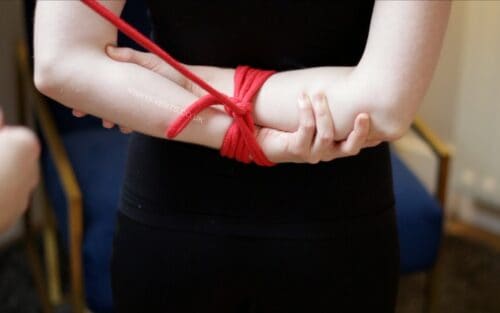
Tie her arms to a chair as a punishment then play with her using toys.

Tie her ankles with one double column tie and wrists behind her back with another. Then use a third rope to connect the ankles to the wrists, pulling her into a hog tie position, face down on the floor.

Rope bondage positions
Once you’ve mastered the basics, you can start to create more complex ties using the rest of the body. Here are a few of the most popular ties you’ll hear about once you start getting more into the rope bondage scene. These help put your submissive into different positions during sexual play
Hishi Karada or rope dress
The Hishi Karada is a single rope decorative full body tie which creates lovely diamond patterns on the body. It’s not restrictive at all and can be worn under clothing. I like to add an optional happy knot between the legs for added stimulation.

Chest harnesses
The chest harness is another decorative tie like the rope dress but only covers the breasts. Chest harnesses are also useful for attaching things to, such as other limbs, so are worth learning as a foundation tie.

Hog tie bondage position
The hog tie is another classic rope bondage positions. The submissive is restrained face down with her hands and ankles bound together. The ankles and wrists are pulled together creating a small arch in the back, making it almost impossible to escape from the position. The hog tie is great for those who enjoy CNC play.

Takate Kote bondage position
The Takate Kote is a classic bondage position which restricts the hands behind the back in a box shape, and also binds the shoulders and breasts. I think you’ll agree it looks pretty stunning. They are many variations of the Takate Kote position – it’s up to you to experiment and find the one which you like the best.


The Shrimp Tie position
The shrimp tie is a very restrictive bondage position and more for punishment purposes rather than for use during sex. It restrains the rope bottom in a crossed legged and hunched over position, pulling the neck towards the ankles. I don’t tie this one as it renders your submissive completely inaccessible for fun, but you sadist Doms out there will probably love it.
There are many, MANY more ties and rope bondage positions out there. I’ve picked out those which suit a D/s dynamic and included them all in my rope bondage video course. I show you exactly how to tie them and how I use them in sexual play. For more information visit the rope bondage course page.
Rounding up this beginner’s guide to rope bondage
There you have it, the complete guide to rope bondage for the beginner. I hope you found it useful and know understand:
- What rope bondage involves
- How it can be incorporated into a dom sub dynamic
- Why submissives enjoy being restrained
- How to practise rope bondage safely
- Which rope to buy and why
- The foundation knots you need to learn
- Knowledge of the main ties and positions to get you started
I cover all of this in more detail plus many other tips on using rope bondage for sexual play in my Rope Bondage for D/s Dynamics online video course. Do check it out if I’ve piqued your interest.
Until next time, stay kinky.


